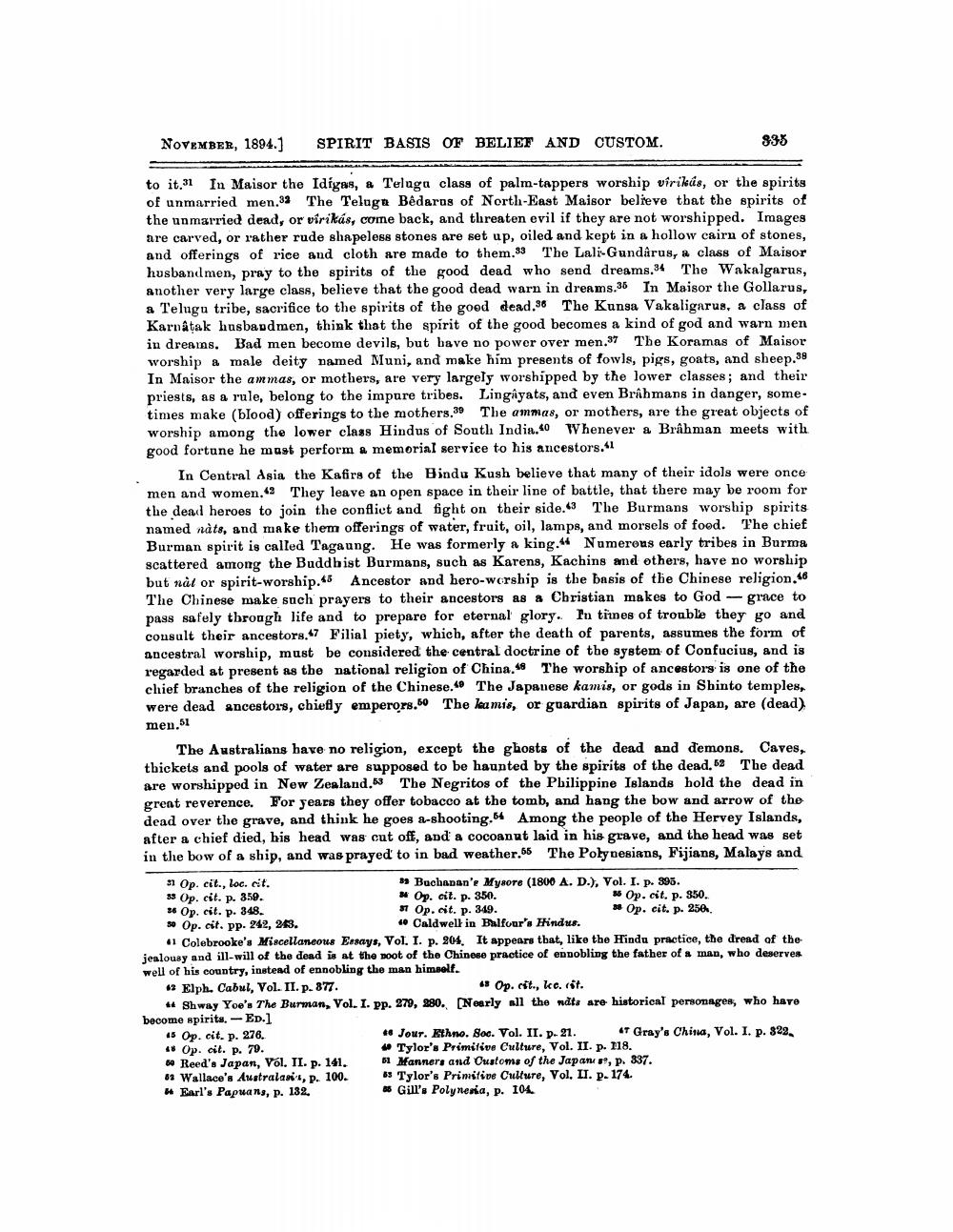________________
NOVEMBER, 1894.)
SPIRIT BASIS OF BELIEF AND CUSTOM.
838
to it.31 In Maisor the Idigas, a Teluga class of palm-tappers worship virilús, or the spirits of unmarried men.32 The Teluga Bédards of North-East Maisor believe that the spirits of the unmarried dead, or virikás, come back, and tlıreaten evil if they are not worshipped. Images are carved, or rather rude shapeless stones are set up, oiled and kept in a hollow cairn of stones, and offerings of rice and cloth are made to them. The Lali-Gundarus, # class of Maisor husband men, pray to the spirits of the good dead who send dreams.34 The Wakalgarus, another very large class, believe that the good dead warn in dreams.36 In Maisor the Gollarus, a Telugu tribe, sacrifice to the spirits of the good dead.36 The Kunsa Vakaligarus, a class of Karnatak husbaudmen, think that the spirit of the good becomes a kind of god and warn men in dreams. Bad men become devils, but have no power over men.37 The Koramas of Maisor worship a male deity named Muni, and make him presents of fowls, pigs, goats, and sheep.38 In Maisor the ammas, or mothers, are very largely worshipped by the lower classes; and their priests, as a rule, belong to the impure tribes. Lingayats, and even Brahmans in danger, sometimes make (blood) offerings to the mothers.39 The ammas, or mothers, are the great objects of worship among the lower class Hindus of South India.co Whenever a Brahman meets with good fortune he must perform a memorial service to his ancestors."
In Central Asia the Kafira of the Bindu Kush believe that many of their idols were once men and women. They leave an open space in their line of battle, that there may be room for the dead heroes to join the conflict and fight on their side. The Burmans worship spirits named nåts, and make them offerings of water, fruit, oil, lamps, and morsels of food. The chief Burman spirit is called Tagaung. He was formerly a king. Numerous early tribes in Burma scattered among the Buddhist Burmans, such as Karens, Kachins and others, have no worship but nåt or spirit-worship. Ancestor and hero-wership is the basis of the Chinese religion. The Chinese make such prayers to their ancestors as a Christian makes to God - grace to pass safely through life and to prepare for eternal glory. In tiines of trouble they go and consult their ancestors.7 Filial piety, which, after the death of parents, assumes the form of ancestral worship, must be considered the central doctrine of the system of Confucius, and is regarded at present as the national religion of China. The worship of ancestors is one of the chief branches of the religion of the Chinese. The Japanese kamis, or gods in Shinto temples, were dead ancestors, chiefly emperors. The la mis, or guardian spirits of Japan, are (dead) men.51
The Australians have no religion, except the ghosts of the dead and demons. Caves, thickets and pools of water are supposed to be haunted by the spirits of the dead. 52 The dead are worshipped in New Zealand. The Negritos of the Philippine Islands hold the dead in grent reverence. For years they offer tobacco at the tomb, and hang the bow and arrow of the dead over the grave, and think he goes a-shooting 54 Among the people of the Hervey Islands, after a chief died, his head was cut off, and a cocoanut laid in his grave, and the head was set in the bow of a ship, and was prayed to in bad weather.56 The Polynesians, Fijians, Malays and 31 Op. cit., loc. cit.
» Buchanan'e Mysore (1800 A. D.), Vol. I. p. 395. 33 Op. cit. p. 359.
* Op. cit. p. 350.
* Op. cit. p. 350. *6 Op. cit. p. 348.
37 Op. cit. p. 349.
* Op. cit. p. 250 5 Op. cit. pp. 242, 263.
4 Caldwell in Balfour's Hindus. Colebrooke's Miscellaneous Besays, Vol. I. p. 204. It appears that, like the Hindu practice, the dread of the jealousy and ill-will of the dead is at the noot of the Chinese practice of ennobling the father of a man, who deserves well of his country, instead of ennobling the man himself. * Elph. Cabul, Vol. II. p. 877.
43 Op. cit., kc. cit. ** Shway Yoe's The Burman, Vol. I. pp. 279, 280., (Nearly all the waits are historical personages, who have become spirits. -Ed.] 15 Op. cit. p. 276.
Jour. Ethno. Soc. Vol. II. p. 21. 4T Gray's China, Vol. I. p. 322 ** Op. cit. p. 70.
Tylor's Primitive Culture, Vol. II. p. 118. 60 Reed's Japan, Vol. II. p. 141. 51 Manners and Customs of the Japanu s, p. 337. 63 Wallace's Australasi, p. 100. * Tylor's Primitive Culture, Vol. II. p. 174. * Earl's Papuans, p. 132.
* Gill's Polynena, p. 104




